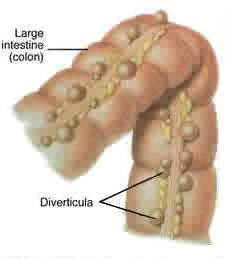Diverticulitis -
Your Gut Feelings
A large number of us "baby boomers" have diverticulitis.
As we age, the condition becomes more common. Almost half of all people over the age of 60 have diverticulosis.
When under pressure, small pouches in the colon bulge outward through weak spots. Each pouch is called a diverticulum. The pouches are called diverticula.
The condition of having diverticulas called diverticulosis.
 When the pouches become infected or inflamed, the condition is called diverticulitis. This happens in 10 to 25 percent of people with diverticulosis. Diverticulosis and diverticulitis are also known as diverticular disease.
When the pouches become infected or inflamed, the condition is called diverticulitis. This happens in 10 to 25 percent of people with diverticulosis. Diverticulosis and diverticulitis are also known as diverticular disease.
A visit to your doctor
The doctor may ask about bowel habits, pain, symptoms, diet, and medications. The exam usually involves a digital rectal exam where the doctor inserts a gloved, lubricated finger into the rectum to detect tenderness, blood, or blockage. The stool may be checked for signs of bleeding or infection. X-rays or other tests may be ordered.
What is the medical treatment for diverticulitis?

If cramps, bloating, and constipation are problems the doctor may prescribe a short course of pain medication which may help relieve symptoms. Many medications affect emptying of the colon which is an undesirable side effect for people with diverticulitis.
A fiber product such as Citrucel or Metamucil may be recommended once a day. When mixed with 8 ounces of water, these products provide about 2 to 3.5 grams of fiber per tablespoon.
If treated early, an attack of diverticulitis without complications may respond to antibiotics and a liquid diet within a few days. Antibiotics are given by injection into a vein. Treatment for diverticulitis focuses on clearing up the infection and inflammation, resting the colon, and preventing or minimizing complications.
When is surgery necessary?
The doctor may advise surgery if attacks are severe or frequent. The affected part of the colon is removed and joins the remaining sections. This surgery is called a colon resection. It aims to keep attacks from reoccuring and to prevent complications. Surgery may be recommended for complications of a fistula or intestinal obstruction.
Emergency surgery may be required for a large abscess, perforation, peritonitis, or continued bleeding. Emergency surgery usually involves two operations.
In the first surgery, the infected abdominal cavity is cleared and part of the colon is removed. It is not safe to rejoin the colon during the first operation because of possible infection and obstruction.
Instead, the surgeon creates a temporary hole in the abdomen called a stoma. The end of the colon is connected to the hole to allow normal eating and bowel movements. This procedure is called a colostomy. The stool goes into a bag attached to the opening in the abdomen.
In the second operation, the surgeon rejoins the ends of the colon.
Connecting to high fiber
The most likely cause of diverticulitis is a low fiber diet because it increases constipation and therefore increases pressure inside the colon during elimination.
Foods that may irritate or get caught in the diverticula such as nuts, popcorn hulls, and sunflower, pumpkin, caraway, and sesame seeds should be avoided. The seeds in tomatoes, zucchini, cucumbers, strawberries, raspberries, as well as poppy seeds are considered mostly harmless.
Any person with diverticulitis should make decisions about their diet based on what works best for them. A food diary may help identify items in one's diet that give cause to avoid them.
A high fiber diet is important in preventing symptoms. Increasing the amount of fiber in the diet may reduce symptoms of diverticulitis and prevent complications. Fiber keeps stool soft and lowers pressure inside the colon so that the bowel moves easily.
The American Dietetic Association recommends 20 to 35 grams of fiber daily.
The New USDA Food Pyramid
recommends 30g per day.
For most people with diverticulosis, eating a high fiber diet is the only treatment needed. You can increase your fiber intake by eating these foods such as: whole grain breads and bran cereals; apples and peaches; broccoli, cabbage, spinach, carrots, asparagus, and squash; starchy vegetables like beans.
Follow these links to the great information on specific recipes and menus for diverticulitis sufferers. And, at the same time, get back to health!